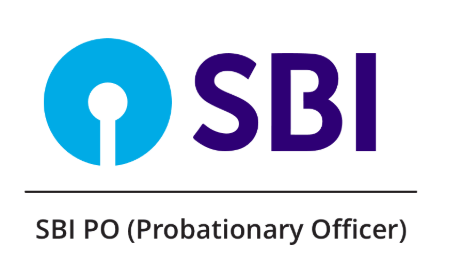SBI PO Exam Paper - (Data Analysis and Intelligence) "held on 30-11-2014"
SBI PO Exam Paper - (Data Analysis and Intelligence) "held on 30-11-2014"
(Based on Memory)
Directions (Q. Nos. 101-106) In these questions a number of series is given. After the series a number is given followed by (a), (b), (c), (d) and (e). You have to complete the series starting with the given numbers following the sequence of original series and answer the questions that follows the series.
101. 48 24 36 90 315 1417.5
20 (a) (b) (c) (d) (e)
What will come in place of (d)?
(1) 131.25
(2) 133.75
(3) 136
(4) 140
(5) 142.25
102. 2 11 52 183 430 555
4 (a) (b) (c) (d) (e)
What will come in place of (b)?
(1) 92
(2) 98
(3) 82
(4) 88
(5) 96
103. 7 9 21 69 273 1371
6 (a) (b) (c) (d) (e)
What will come in place of (b)?
(1) 19
(2) 22
(3) 18
(4) 20
(5) 17
DOWNLOAD SBI PO Question Papers PDF
DOWNLOAD SBI CLERK Question Papers PDF
DOWNLOAD MORE BANK EXAMS E-BOOKS
Printed Study Material for SBI PO Exam
104. 9 8 12 27 92 435
7 (a) (b) (c) (d) (e)
What will come in place of (c)?
(1) 19
(2) 12
(3) 13
(4) 15
(5) 16
105. 8 9 21 68 279 1404
5 (a) (b) (c) (d) (e)
What will come in place of (d)?
(1) 184
(2) 207
(3) 212
(4) 196
(5) 228
106. 4 7 19 73 381 2161
8 (a) (b) (c) (d) (e)
What will come in place of (c)?
(1) 106
(2) 169
(3) 156
(4) 184
(5) 174
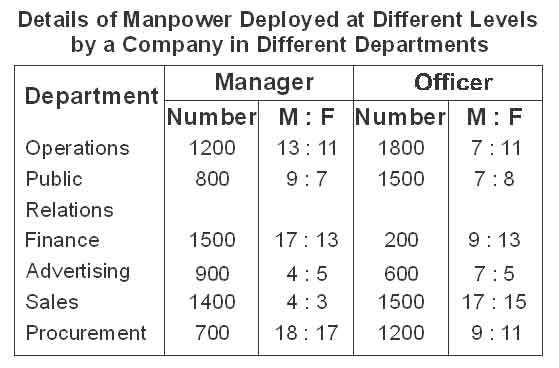
107. Total number of female employees (manager and officers) in procurement department is by what percent more than their male counter part?
(1)9%
(2)79/7 %
(3)45/4%
(4)104/11%
(5)100/11%
108. What is the difference between total number of male officers in Advertising and Public Relations Departments and the total number of female managers in these two departments?
(1) 240
(2) 180
(3) 150
(4) 200
(5) 220
109. What is the respective ratio between total number of female managers from Operations and Finance departments and the total numbers of male officers from these two departments?
(1) 4 : 5
(2) 3 : 5
(3) 1 : 2
(4) 3 : 4
(5) 2 : 3
110. Total number of male officers in Advertising and Sale departement is what percent of the total number of officers in the two departments?
(1) 52
(2) 54
(3) 56
(4) 58
(5) 54
111. Total number of female managers in Finance department is what percent of the total number of male employees in sales department?
(1) 72.5
(2) 76.25
(3) 40
(4) 82.75
(5) 88.5
112. What is the ratio between of total number of managers in Public Relation, Finance and Sales, and Operation departments and the total number of officers in Finance Advertising, Sales and Procurement departments, respectively?
(1) 7 : 8
(2) 11 : 13
(3) 6 : 7
(4) 13 : 15
(5) 13 : 16
113. What is the speed of the train? (in km/h)
I. The car takes 2 h more than the train to cover a distance of 264 km.
II. The train moves 22 km/h faster than the car.
(1) If the data either in statement I alone or in statement Ii alone are sufficient to answer the question
(2) If the data in both the statements I and II together are not sufficient to answer the question
(3) If the data in both the statements I and II together are necessary to answer the question
(4) If the data in statement I alone are sufficient to answer the question while the data in statement II are not sufficient to answer the question
(5) If the data in statement II alone are sufficient to answer the question while the data in statement I are not sufficient to answer the question
114. How many students are there in the class?
I. The average weights of the class is 52 kg.
II. If two students weighing 44 kg and 52 kg leave the class and are replaced by two students weighing 64 kg and 56 kg. The average weight of the class increases by 1.2 kg.
(1) If the data either in statement I alone or in statement II alone are sufficient to answer the question
(2) If the data in both the statements I and II together are not sufficient to answer the question
(3) If the data in both the statements I and II together are necessary to answer the question
(4) If the data in statement I alone are sufficient to answer the question while the data in statement II are not sufficient to answer the question
(5) If the data in statement II alone are sufficient to answer the question while the data in statement I are not sufficient to answer the question
115. In how many days can 14 men complete a piece of wouk?
I 18 women can complete that work in 24 days.
II. 28 children can complete that work in 56 days.
(1) If the data either in statement I alone or in statement II alone are sufficient to answer the question
(2) If the data in both the statements I and II together are not sufficient to answer the question
(3) If the data in both the statements I and II together are necessary to answer the question
(4) If the data in statement I alone are sufficient to answer the question while the data in statement II are not sufficient to answer the question
(5) If the data in statement II alone are sufficient to answer the question while the data in statement I are not sufficient to answer the question
116. What was the percentage of discount given on the marked price of the table?
I. 15% profit was earned by selling the table for Rs. 14490. If there were not discount, percent profit would have been 20%.
II. Cost price of table is Rs. 12600.
(1) If the data either in statement I alone or in statement II alone are sufficient to answer the question
(2) If the data in both the statement I and II together are not sufficient to answer the question
(3) If the data in both the statements I and II together are necessary to answer the question
(4) If the data in statement I alone are sufficient to answer the question while the data in statement II are not sufficient to answer the question
(5) If the data in statement II alone are sufficient to answer the question while the data in statement I are not sufficient to answer the question
117. What is area of the circle? (in sq cm)
I. The diameter of the circle is 90 cm less than its circumference
II. The radius of the circle is equal to the length of a rectangle whose perimeter in 77 cm.
(1) If the data either in statement I alone or in statement II alone are sufficient to answer the question
(2) If the data in both the statements I and II together are not sufficient to answer the question
(3) If the data in both the statements I and II together are necessary to answer the question
(4) If the data in statement I alone are sufficient to answer the question while the data in statement II are not sufficient to anwer the question
(5) If the data in statement II alone are sufficient to answer the question while the data in statement I are not sufficient to answer the question
A bag contains four blue shirts five red shirts and six yellow shirts.s
118. Three shirts are drawn randomly. What is the probability that exactly one of them is blue?
(1) 36/91
(2) 40/91
(3) 44/91
(4) 48/91
(5) 31/91
119. One shirt is drawn randomly. What is the probability that it is either red or yellow?
(1) 4/15
(2) 7/15
(3) 11/15
(4) 8/15
(5) 13/15
120. Two shirts are drawn randomly. What is the probability that both of them are blue?
(1) 3/35
(2) 1/35
(3) 2/35
(4) 5/35
(5) 6/35
121. If three shirts are drawn random 14, what is the probability that all the three shirts are of different colour.
(1)24/91
(2)36/91
(3)12/91
(4)42/91
(5)None of these
122. What will the total cost of flooring the hall and painting the ceiling?
(1) Rs. 560000
(2) Rs. 576000
(3) Rs. 524000
(4) Rs. 580000
(5) Rs. 564000
123. What will be the cost of painting the four walls of the hall if it has a door of 1.6 m × 2.5 m and a window of 0.8 m × 1.5 m?
(1) Rs. 190900
(2) Rs. 208000
(3) Rs. 196800
(4) Rs. 198600
(5) Rs. 206100
124. What will be the cost of flooring the hall if the contractor offered 12% discount on the total cost?
(1) Rs. 380160
(2) Rs. 336440
(3) Rs. 328240
(4) Rs. 342320
(5) Rs. 360350
125. While painting the hall it was noticed that one wall on length side having no door or window required plastering which will cost Rs. 320/m2. What will be the cost of plastering and painting that particular wall?
(1) Rs. 85600
(2) Rs. 84400
(3) Rs. 82800
(4) Rs. 86400
(5) Rs. 85200
126. What will be the difference between the cost of painting the wall on length side and the wall on breath side neither of the walls has a door or a window?
(1) Rs. 14000
(2) Rs. 15000
(3) Rs. 15600
(4) Rs. 16000
(5) Rs. 14500
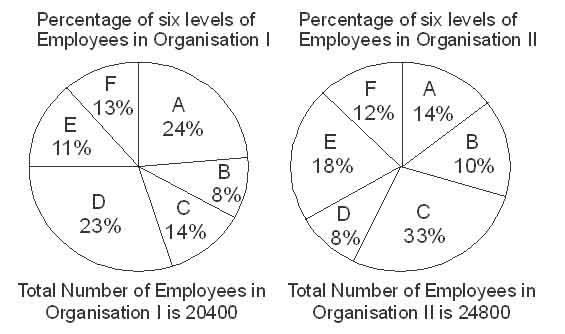
127. The total number of which level employees in both the organsiation together is maximum?
(1) A
(2) F
(3) C
(4) E
(5) D
128. The difference in the number of employees in the two organisation of which level is the maximum?
(1) A
(2) D
(3) E
(4) F
(5) C
129. The number of C level employees in organisation I is approximately equal to the number of which level employees in organisation II?
(1) B
(2) D
(3) F
(4) C
(5) A
130. Number of B level employees in organisation I is less than that in organisation II by what percent approximately?
(1) 60
(2) 55
(3) 59
(4) 40
(5) 45
131. What is the total number of F level employees in organisation level I and E level employees in orgainsation II together?
(1) 7916
(2) 2652
(3) 7116
(4) 8126
(5) 4464
132. The number of A level employees in organisation II is approximately what percentage of the number of D level employees in organisation I?
(1) 30
(2) 62
(3) 57
(4) 48
(5) 43

(Consider each of the given companies equally distributed book among the districutors working with it)
133. What was the average number of books published by companies A, C and D together?
(1) 5700
(2) 5900
(3) 5500
(4) 5300
(5) 6100
134. Number of books distributed by company B is what percent of the number of books distributed by company E?
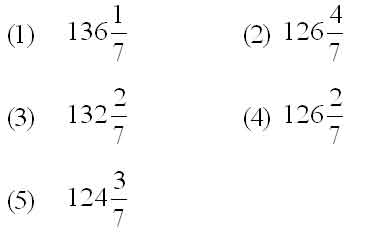
135. Among the total number of books distributed by company D the respective ratio of academic and non-academic books was 5: 4. What was the number of non-academic books distributed by company D?
(1) 1200 (2) 1800
(3) 1400
(4) 1500
(5) 1600
136. Number of books received by each distributor working with company F was what percent more than the number of books received by each distributor working with company E?

137. What was the respective ratio between total number of books distributed by company A and the total number of books distributed by company C?
(1) 53 : 88
(2) 171 : 176
(3) 53 : 92
(4) 49 : 82
(5) 57 : 92
138. What was the difference between number of books received by each distributor working with company B and number of books received by each distributor working with company F?
(1) 252
(2) 260
(3) 264
(4) 268
(5) 256

139. What is the percentage increase in the income of company Y from 2008 to 2010?
(1) 103/2
(2) 80/3
(3) 100/3
(4) 119/3
(5) 105/4
140. The total income of all the three companies together was minimum in which of the following years?
(1) 2011
(2) 2008
(3) 2009
(4) 2012
(5) 2007
141. In which year was the percentage increase in income of company Z from the previous year the maximum?
(1) 2010
(2) 2008
(3) 2012
(4) 2011
(5) 2009
142. What is the approximate average income of all the three companies together in 2011?
(1) Rs. 210 crore
(2) Rs. 240 crore
(3) Rs. 300 crore
(4) Rs. 260 crore
(5) Rs. 250 crore
143. What is the ratio between the total income of all three companies in 2007 and 2008, respectively?
(1) 5 : 7
(2) 4 : 7
(3) 3 : 4
(4) 4 : 5
(5) 3 : 5
144. The income of company Z in 2010 is what percentage of income of company y in 2011?
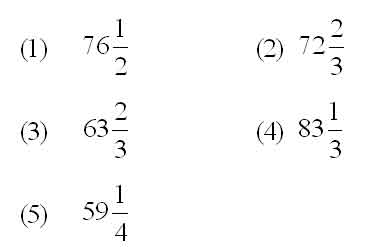
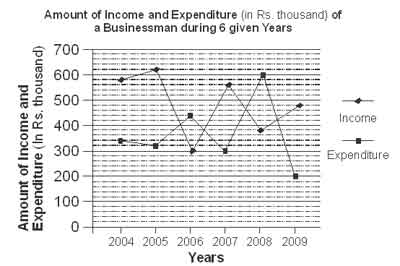
Note (i) Profit = Income – Expenditure
(ii) Percent Profit = (Profit/Expenditure) = 100
(iii) Loss = Expenditure – Income
(iv) Percent Loss = (Loss/Expenditure) = 100
145. What is the total profit earned by the businessman in 2005 and 2008?
(1) 50 thousand
(2) 52 thousand
(3) 55 thousand
(4) 58 thousand
(5) 60 thousand
146. What is average profit earned by the businessman in 2005, 2007 and 2009 together? (in Rs. thousand)
(1) 240
(2) 260
(3) 320
(4) 280
(5) 360
147. What is the respective ratio between total profit earned by the businessman in 2004 and 2009 together and total loss incurred by him in 2006 and 2008 together?
(1) 13 : 11
(2) 11 : 7
(3) 11 : 9
(4) 15 : 13
(5) 13 : 9
148. Profit earned by the businessman in 2009 is what percent more than the profit earned by him in 2004?
(1) 162/3
(2) 221/3
(3) 122/3
(4) 142/3
(5) 181/3
149. Expenditure of the businessman increased by what percent from 2005 to 2008?
(1) 92.5
(2) 85
(3) 95
(4) 87.5
(5) 82
150. What is the percent loss incurred by the businessman in 2006 and 2008 together?
(1) 286/13
(2) 3610/13
(3) 321/13
(4) 384/13
(5) 348/13
